Are you looking for various options to waterproof your bathroom floor? There are two options available- either the old hot-mop process or new Schulter membranes.
This article will give you a clear idea of Hot mop vs. Schulter including their various features.
Remodeling a bathroom involves a lot of work; waterproofing the floor is one of the most important aspects we must not forget. Being the most moisturized and wet area in a house, you should give special attention to waterproofing your bathroom floor.
A Quick Comparison Table
Hot mop and Schulter provides waterproofing to your bathroom floor, keeping it safe from water damage.
Although they serve the same purpose, they are entirely different from one another. They differ in material, installation, preparation, function, and other aspects.
Here’s a comparison table between Schulter systems vs. Hot Mop. You can take a glace for a quick idea of how they function differently. It will help you make a decision later.
Comparison
| Feature | Hot Mop | Schluter |
| What is it? | A multi-layered system using hot asphalt or coal tar covered with a membrane | Pre-fabricated, thin waterproof membranes |
| Main Components | Felt paper, hot asphalt/coal tar, fabric-reinforced rubberized asphalt membrane | EPDM rubber or PVC membrane with optional drainage mat |
| Installation Process | Assembly of multiple layers and hot mopping | Peel and stick application of preformed sheets |
| Seams | Seams are hot mopped | Seams sealed with silicone |
| Slope | Slope provided by mortar bed | Slope provided by substrate or foam underlayment |
| Drainage | No built-in drainage system | Can integrate drainage mat for enhanced drainage |
| Crack Prevention | Relies on membrane strength | Includes crack isolation membrane |
| Shower Base Options | Liner installed atop mortar bed | Works with custom bases or prefabs |
| DIY Difficulty | Very difficult, professional installation recommended | Moderate difficulty, DIY friendly |
| Estimated Installation Time | 2-3 days | 1-2 days |
| VOC Emissions | Higher VOCs from hot asphalt | Low to no VOC |
| Ideal For | Concrete substrates | Variety of substrates including wood framing |
| Waterproof Warranty | Varies by product, typically 10-12 years | 10 year warranty |
| Estimated Cost | $6-8/sq.ft. installed | $8-12/sq.ft. installed |
What is Hot Mop Shower Waterproofing?
Hot mopping (also called membrane waterproofing) is a multi-layer, built-up system that uses hot asphalt or coal tar as an adhesive to bond layers of felt paper and fabric-reinforced rubber. This creates a waterproof barrier that is ideal for concrete and masonry substrates.
The hot mopping process involves assembling multiple layers atop one another:
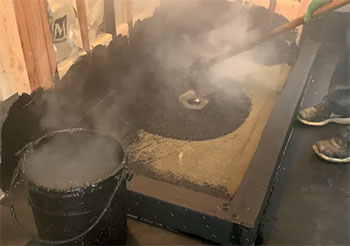
- Mortar bed: A sloped mortar bed is installed and acts as the shower pan to direct water to the drain.
- Felt paper: One or more layers of felt paper are embedded into the mortar while it’s still fresh. The felt paper reinforces the mortar and acts as a bond breaker.
- Hot asphalt/coal tar: Liquid asphalt or coal tar is heated to 300-400°F then mopped continuously over the felt to create an adhesive waterproof coating.
- Membrane: A rubberized asphalt membrane reinforced with fiberglass, polyester, or fiber is embedded into the hot asphalt. This provides the main waterproof barrier.
- Flashing: Additional asphalt and membrane are used to flash vertical surfaces and waterproof corners and joints.
The end result is a contiguous waterproofing system fully adhered to the shower walls and floor. The materials bond together to produce a seamless barrier against leaks and moisture damage.
Pros of Hot Mop Shower Waterproofing:
- Thick system provides excellent waterproofing on concrete substrates
- Layers are fully bonded to prevent leaks at seams or corners
- Sloped mortar pan provides efficient drainage
- With proper installation, can last 20-30 years
Cons of Hot Mop Shower Waterproofing:
- Multi-day installation is labor intensive
- Asphalt has high VOC emissions during installation
- Not DIY friendly, professional installation recommended
- Performing repairs can be difficult compared to sheet membranes
- Mortar pan will eventually crack and require repairs
What is the Schluter Shower System?
The Schluter shower system takes a simpler approach using prefabricated, thin membrane sheets to waterproof shower assemblies. This includes an EPDM rubber or PVC membrane along with optional drainage and crack isolation mats.
Unlike hot mopping, the Schluter system does not require building up layers of materials. Instead, the Schluter membranes are peel-and-stick sheets that adhere directly to the substrate.
Here are the components of the Schluter shower system:
- Substrate: The membranes can be applied onto concrete, mortar beds, cement board, Kerdi board, or even plywood/OSB substrates.
- Waterproof membrane: EPDM or PVC sheets are cut to size and sealed at all seams and corners with silicone.
- Drainage mat (optional): A dimpled mat is placed under the membrane to enhance drainage.
- Crack isolation membrane (optional): An anti-fracture membrane helps prevent substrate cracks.
- Tile: Tile is installed directly onto the membrane using a compatible mortar.
Schluter membranes come preformed with necessary accessories like corner seals, pipe seals, and edge strips to facilitate waterproof installation.
Pros of the Schluter Shower System:
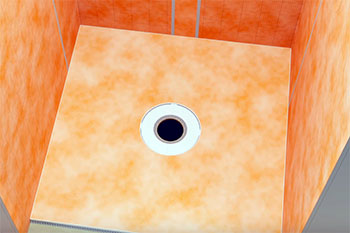
- Thin membranes are lightweight and easy to install
- No VOC or fumes and materials are recyclable
- Works on nearly any substrate beyond just concrete
- Sloped mortar bed isn’t required for drainage
- Integrated crack prevention and enhanced drainage
- Easier repairs by replacing single membrane sheets
- DIY friendly with good instructions and videos
Cons of the Schluter Shower System:
- Requires careful sealing at all seams and corners
- Tile may need to be removed for leak investigation
- 10 year warranty is shorter than some hot mop membranes
- No reinforcement like fibers to enhance membrane strength
Key Differences Between Hot Mop And Schulter Systems
We already know how hot mop and Schulter are different than each other. But for choosing one, we must know their nitty-gritty.
When we look at their materials, how they work, how to install and maintain them, differences in price, etc., we will understand which one will work best.
Hot mop provides excellent waterproofing using hot asphalt and 3 layers of felt paper. It protects your bathroom floor from water leakage and damage and is still popular among most people because of its longevity.
Using PVC/CPE sheet membrane, the Schulter system also provides an excellent seal against water damage and leakage. A new waterproofing technology like this is more durable and highly effective for bathroom floors.
Let’s see the key differences between these two waterproofing systems:
- Materials
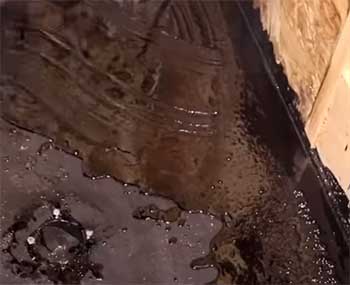
We already know that the hot mop and Schulter system use different materials to provide waterproofing. Both materials are high-quality and provide excellent performance; they work differently.
Hot mop uses hot meltdown asphalt and 3 layers of felt paper to create the seal on your bathroom floor. On the contrary, the Schluter system uses high-quality PVC/CPE membrane sheets to provide waterproofing.
These membrane sheets are made of water-tight materials and have a thin construction.
- Function
Although hot mop and Schulter membranes serve the same purpose, their way is different. They function differently to provide a seal against waterproofing.
It is reliable and still popular with many people because it is the oldest method. 3 layers of felt are attached using hot asphalt tar on your bathroom floor in this process.
In contrast, the Schulter system uses only one layer of thin membrane sheet to seal your floor and wall. They come readymade in different parts for a different area of your bathroom. Being a new technology, this is easier and more durable.
- Preparation
Remodeling your bathroom and waterproofing the floor and the wall is a hectic job.
So many things can go wrong if you do not plan everything out.
A waterproofing project requires preparation, be it a hot mop or Schulter system; you must prepare your bathroom floor beforehand.
Before starting the project, you have to prepare three things for a hot mop.
You must prepare the shower pan or bathroom floor drain, create proper blocking on your drain, and place a curb in the shower pan.
You do not need to do any of it for Schulter, as all the parts for these 3 jobs come with the Schulter package.
- Installation
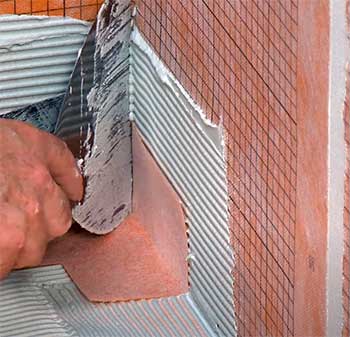
The installation process can make a buyer choose specific products. People always prefer to use or buy things that are easy to install.
The hot mop is an old, reliable way to waterproof your bathroom floor and walls, but installing it is quite a job. You will need at least two trained professionals to complete the job.
On the contrary, Schulter membrane sheets are designed for DIY projects. You can pretty much install it yourself using the user manual. You can take help from your family member or a neighbor.
- Longevity
Waterproofing a bathroom floor and walls is not something you do once a year. With the hassle and bustle, you want your bathroom waterproofing to last as long as possible.
On that note, hot-mop typically lasts for 15 years, and after that, you will have to do it all over again. Otherwise, your house structure can become seriously damaged.
On the other hand, Schulter membranes are made from water-tight PVC/CPE materials. They will last longer than hot mope. It’s also easier to remove when you have to reinstall them.
- Costing
Price will create an impact while choosing a product. You would want a better product at a low cost.
Hot mopping a shower pan will cost you $225 and $500, depending on how many experts you hire.
The cost will rise significantly for an entire bathroom floor. In contrast, Schulter membrane sheets come as different kits.
A 54 SQ FT Schulter Kerdi will cost you $73.31. You have to measure the area first and order accordingly.
Which Waterproofing System Is Best For You?
The above discussion shows that hot mopping is an old technique, reliable, and still popular with many people.
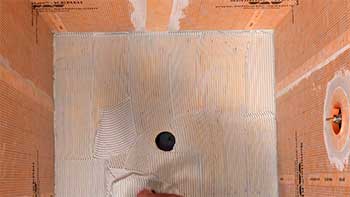
But at the same time, it requires a lot of preparation, as well as the installation involves a lot of human resources and processes. It will cost you a chunk of money and last for about 15 years.
In contrast, the Schulter system comes in various combo kits, consisting of all necessary items for installation. You can install it yourself if you have it in you, as it’s pretty easy to install.
The PVC membrane sheets cost significantly lower and will last a lifetime.
With all the pros and cons of the two waterproofing systems, I suggest you use Schulte membrane sheets for your bathroom.
Frequently Asked Questions (FAQ)
Schulter is the new way to waterproof your bathroom floor, wall, or shower pan. It is a great product and lasts significantly longer than traditional ones. The installation process is also easy, and the cost is lower.
The hot mop is a way to waterproof your bathroom walls, floor, and shower pan. You must waterproof your bathroom floor. But there are other ways available, like installing Schulter PVC membrane sheets.
Hot mop being a traditional way of waterproofing provides good performance and lasts for at least 15 years. Thus it became a reliable method. But there are other new technologies available now.
A hot mop can protect your shower pan from water leakage. To hot-mop a shower pan, you will require $225- $500 depending on the size of the shower pan and human resources.
Both hot mop and membrane systems (like Schluter) can provide effective waterproofing for showers when installed properly. Hot mop provides a thicker built-up layered system that bonds strongly to concrete. Membranes are thinner and easier to install but require careful seam sealing. For concrete substrates, hot mop is generally considered the more robust and durable waterproofing option.
Final Words
A bathroom floor or shower pan leakage can make your life harder in ways you can’t even imagine. That is why there is no other option but to choose the right waterproofing system.
How easy and fast you can install depends on what products you choose.
It’s precisely why it’s essential to know hot-mop vs. Schulter systems, and you know it now. So go and purchase the right one.
Best of luck!

Hello, Clyde, if you don’t mind my asking a question-our contractor did a hot mop but we changed to a new contractor who said he is going to put Schluter on top of the hot mop. What is your opinion on this? Thank you.